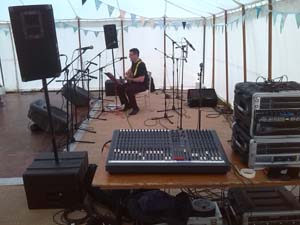
System CrossoverĪfter the mixer has done it’s job, it then sends the signal to a system crossover.Ī system crossover is a piece of equipment that divides your sound system into sections based upon frequency content. So as you can see, monitors are essential for anyone performing or speaking from a stage. It can be a little weird, or even difficult sometimes, to speak without a monitor. Monitors are also used for public speakers. The drummer may be hearing a lot of drums and bass, while the guitar player only wants to hear his/her guitar and the lead vocal. Most of the time, each member you see on stage will be hearing something different. Monitors are used for musicians on stage so that they can hear themselves. The monitors are controlled either from the mixer mentioned above, or a separate dedicated mixer. Other consoles, however, can have dozens or even hundreds of channels for larger and more advanced needs, such as concerts or theatres. Some consoles are very basic, only consisting of a few channels for a few sources. The job of the console is to set the signal of the source to a practical level, adjust the tone of the source to a desired sound, and then send it to the next part of the chain. We mix engineers often get asked if we know what each knob and button does. They are the big table looking things sitting out in the audience with all the buttons, sliders, knobs and lights. You’ve probably seen a console before, especially if you’ve been to a concert. Your source sound will then travel through some cables and enter a sound mixer – a.k.a mixer/console/desk. Maybe a piano or a violin – or even all of them at once! At concerts and theatres, it’s common to use dozens to hundreds of inputs! Sound Mixer There are countless sources of sound you can start with. So, what is the input? Well, it could be anything. If you don’t have an input at the beginning of your chain, the rest of the system is useless because you will have nothing to amplify. Let’s take a look at each part of the system and get a better understanding of its importance. However, the more advanced a system becomes, the more these components are separated into individual pieces. These include things like a mixing console, crossover, power amps, speakers, etc… Sometimes, many of these things are combined into one piece of gear in order to make it simpler for the end user. There are many components to every sound system. Well, the logic is very simple, but the implementation… not as much. Because they are typically the most complex type of sound system and it will be the easiest way to understand each component.īut remember, all sound systems in some shape or form use the same basic components, which is what we will talk about here.īefore we get into how they work, let’s take a moment to address the purpose of them.Įssentially, the goal of the sound system is to take a small audio signal and amplify it so that that it can be heard louder and/or by more people.

Because live audio is my job and is what this site is all about!.In this article, I will focus on live sound PA systems – the kind you would see at a concert. Read on to find out more! How Does a Sound System Work? However, they all consist of the same basic components. There are many types of sounds systems – some simple and some very complex.

#Live sound systems series
How does a sound system work? Sound systems work by taking an audio input signal, processing and amplifying it through a series of equipment in a specific order and then outputting the signal through one or more loudspeakers. But at the end of the day, they all work in the same basic way. Sound systems are everywhere concerts, weddings, churches, theatres, amusement parks, etc… Sometimes they’re big and sometimes they’re small. Almost everyone has encountered a sound system in their life.


 0 kommentar(er)
0 kommentar(er)
